Related Research Articles

A pension is a fund into which amounts are paid regularly during an individual's working career, and from which periodic payments are made to support the person's retirement from work. A pension may be:
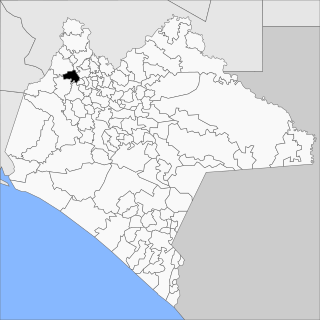
Francisco León is a municipality in the Mexican state of Chiapas. It covers an area of 114.3 km². In 1982 parts of the municipality were buried in the eruption of El Chichón Volcano.
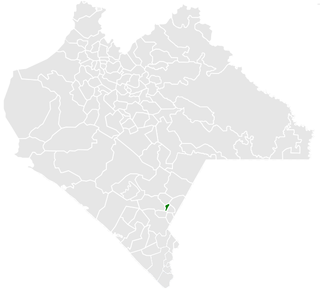
La Grandeza is a town and municipality in the Mexican state of Chiapas in southern Mexico.

Huitiupán is a town and municipality in the Mexican state of Chiapas in southern Mexico.

Ixtapangajoya is a town and municipality in the Mexican state of Chiapas in southern Mexico.

San Juan Cancuc is a town and municipality in the Mexican state of Chiapas in southern Mexico.

La Libertad is a town and municipality in the Mexican state of Chiapas in southern Mexico.
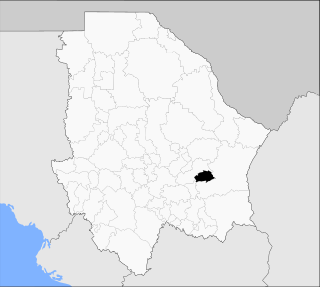
La Cruz is one of the 67 municipalities of Chihuahua, in northern Mexico. The municipal seat lies at La Cruz. The municipality covers an area of 1,035.9 km².

Poanas is a municipality in the Mexican state of Durango. The municipal seat lies at Villa Unión. The municipality covers an area of 1841 km2.
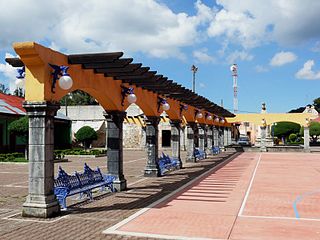
Omitlán de Juárez is a town and one of the 84 municipalities of Hidalgo, in central-eastern Mexico. The municipality covers an area of 110.5 km².

Poverty in Mexico deals with the incidence of poverty in Mexico and its measurement. It is measured based on social development laws in the country and under parameters such as nutrition, clean water, shelter, education, health care, social security, quality and availability of basic services in households, income and social cohesion. It is divided in two categories: moderate poverty and extreme poverty.
A social pension is a stream of payments from state to an individual that starts when someone retires and continues in payment until death. It is a part of a pension system of most developed countries, specifically the so-called zero or first pillar of the pension system, which is a part of state social security system. The social pension is different from other types of pension since its eligibility criteria do not require former contributions of an individual, but citizenship or residency and age or other criteria set by government.
In France, pensions fall into five major divisions;
Pensions in Spain consist of a mandatory state pension scheme, and voluntary company and individual pension provision.
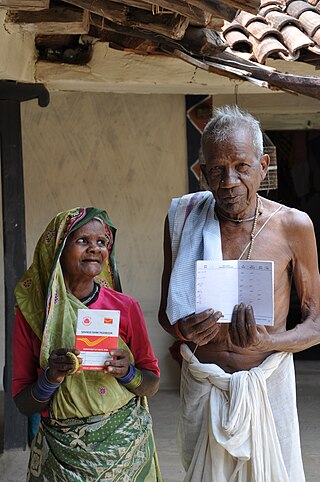
The National Social Assistance Programme (NSAP) is a Centrally Sponsored Scheme of the Government of India that provides financial assistance to the elderly, widows and persons with disabilities in the form of social pensions. The NSAP scheme only includes Below Poverty Line individuals as beneficiaries.
The National Crusade Against Hunger is a program sponsored by the Mexican government. Its main purpose is to significantly reduce hunger and poverty in Mexico through social intervention, increasing the general socio economic status of the communities by the development of infrastructure. It was announced on December 1, 2012 by Mexican president Enrique Peña Nieto during his inauguration. The program started on January 21, 2013 with an event in Las Margaritas, Chiapas.

The National Council for the Evaluation of Social Development Policy is a Mexican organization coordinated by the Secretariat of Welfare. CONEVAL is an autonomous constitutional organization with legal personality, own proprietorship, technical and management autonomy.

Instituto Nacional de las Personas Adultas Mayores (INAPAM) is a Mexican public welfare organization for families, composed of offices run by both federal and state governments. INAPAM offers programs to improve the well-being of the elderly. Services include providing education regarding physical and mental health, hosting different cultural activities, and holding job expositions. Also, INAPAM offers training for people 65 years-of-age and older to become authorized caretakers for the elderly, and offers various benefits like discounts on clothing, entertainment venues and hotels.

Gonzalo Hernández Licona is a Mexican economist and distinguished scholar in the fields of poverty measurement, economic development and social program evaluation. Hernández Licona holds a PhD in economics from the University of Oxford, a master's in economics from the University of Essex and a B.A. in economics from the Mexico Autonomous Institute of Technology (ITAM).

Mexico has a thriving, diverse economy with strong macroeconomic institutions and is open to trade and private investment. With a population of over 130 million, Mexico is filled with citizens in the upper middle income bracket. Its economy is the 11th fastest growing in the world. Low growth rates and significant inequalities continue to hamper the growth of the Mexican economy. This is a central issue and is addressed in the systematic country diagnostic. The World Bank Group (WBG) discussed its support for the new Country Partnership Framework (CPF) for Mexico on February 27, 2020. The CPF covers a six-year period (2020-2025) and aligns the WBG’s engagement with the government’s National Development Plan. The CPF builds on the analysis of the Systematic Country Diagnostic (SCD) and reflects the views and strategy of the authorities on the way to foster growth and poverty reduction.
References
- 1 2 3 4 5 6 Secretaria de Desarrollo Social (SEDESOL). "Pension para Adultos Mayores. Reglas de Operacion 2014" (PDF). Diario Oficial de la Federacion. Retrieved 17 April 2014.
- 1 2 3 Aguila, Emma; Diaz, M; Manqing, M; Kapteyn, A; Pierson, A. (2011). "Living Longer in Mexico: Income Security and Health" (PDF). Rand Health Quarterly. AARP, RAND, Centro Fox. 1 (4): 1. PMC 4945250 . PMID 28083208 . Retrieved 26 April 2014.
- ↑ Instituto Nacional de Salud Pública (2012). "Encuesta Nacional de Salud y Nutrición 2012. Resultados nacionales" (PDF). Archived from the original (PDF) on 21 October 2014. Retrieved 26 April 2014.
- 1 2 3 4 5 Aguila, Emma; Mejia, N; Perez-Arce, F; Rivera, A (2013). "Programas de Pensiones No Contributivas y su Viabilidad Financiera. El Caso de Mexico" (PDF). RAND Labor & Population. Retrieved 26 April 2014.
- ↑ INEGI (2005). "Los adultos mayores en México. Perfil sociodemográfico al inicio del siglo XXI" (PDF). Instituto Nacional de Estadistica, Geografia e Informatica. Retrieved 26 April 2014.
- ↑ INEGI (2012). "ESTADÍSTICAS A PROPÓSITO DEL DÍA INTERNACIONAL DE LAS PERSONAS DE EDAD. DATOS NACIONALES" (PDF). Instituto Nacional de Estadística, Geografía e Informática. Retrieved 26 April 2014.
- ↑ SEDESOL (2013). "Diagnóstico del Programa Pensión para Adultos Mayores" (PDF). Secretaría de Desarrollo Social. Retrieved 26 April 2014.
- ↑ Ham Chande, Roberto (2011). "Diagnóstico socio-demográfico del envejecimiento en México". Consejo Nacional de Población (CONAPO). Retrieved 26 April 2014.
- ↑ INAPAM (2010). "Ejes rectores de la política pública nacional a favor de las personas adultas mayores" (PDF). Instituto Nacional de las Personas Adultas Mayores (SEDESOL). Retrieved 27 April 2014.
- ↑ Consejo Nacional de Evaluación de la Política de Desarrollo Social (CONEVAL) (Aug 28, 2008). "Dia de la Poblacion Adulta Mayor". CONEVAL. Retrieved 27 April 2014.
- 1 2 CONEVAL (2012). "Informe de la Evaluación Específica de Desempeño 2012 – 2013, Programa 70 y más / Pensión para Adultos Mayores" (PDF). Consejo Nacional de Evaluación de la Política de Desarrollo Social. Retrieved 27 April 2014.
- ↑ Gobierno de la Republica (2012). "Plan Nacional de Desarrollo 2013–2018" (PDF). Gobierno de la Republica, Mexico. Retrieved 27 April 2014.
- ↑ Secretaria de Desarrollo Social (SEDESOL) (2013). "ACUERDO POR EL QUE SE EMITEN LAS REGLAS DE OPERACION DEL PROGRAMA DE PENSION PARA ADULTOS MAYORES, PARA EL EJERCICIO FISCAL 2013" . Retrieved 27 April 2014.
- ↑ Organisation for Economic Co-Operation and Development (OECD) (2012). "OECD Stat Extracts, Economic Outlook No 91 – June 2012 – Long-term baseline projections" . Retrieved 27 April 2014.
- ↑ OECD, Inter-American Development Bank and The World Bank (2014). Pensions at a Glance: Latin America and the Caribbean. doi:10.1787/pension_glance-2014-en. hdl:10986/21426. ISBN 978-92-64-22054-6.
- ↑ Alonso, Hoyo,Tuesta, J. ,C.,D. (2014). "A model for the pension system in Mexico: diagnosis and recommendations". Journal of Pension Economics and Finance. 14 Num 1.
{{cite journal}}: CS1 maint: multiple names: authors list (link) - ↑ Estudio de la OCDE sobre los sistemas de pensiones. 2016. doi:10.1787/9789264250017-es. ISBN 9789264250017.
- ↑ Wong, Diaz, R,JJ (2007). Health care utilization among older Mexicans: health and socioeconomic inequalities, Salud Pública de México. pp. 515–514.
{{cite book}}: CS1 maint: multiple names: authors list (link) - ↑ "Pensiones estatales: Otra bomba de tiempo" (PDF). 2012.
- ↑ OECD Economic Surveys: Mexico 2013. París: OECD. 2013.
- ↑ "La transición del sistema mexicano de pensiones hacia un sistema de cuentas individuales de contribución definida ha aumentado su sostenibilidad financiera, afirma un estudio de la OCDE - OECD". www.oecd.org.
- ↑ Willmore, Larry (2007). "Universal Pensions for Developing Countries". World Development. 35 (1): 24–51. doi:10.1016/j.worlddev.2006.09.008.
- ↑ Levy, Santiago; Schady, Norbert (2013). "Latin America's Social Policy Challenge: Education, Social Insurance, Redistribution". Journal of Economic Perspectives. 27 (2): 193–218. doi:10.1257/jep.27.2.193. S2CID 153814272.